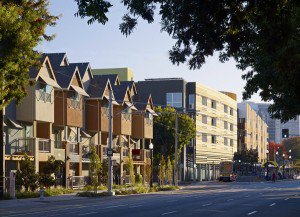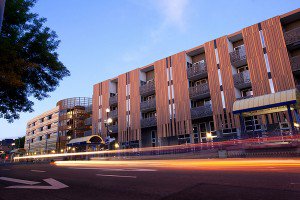By Yardi Blog Staff on February 5, 2014 in News
Smart growth approaches have proven effective in reshaping the face of t he built environment. Communities across the country, be it urban hubs or bedroom communities, cities, towns or rural places, have embraced green building principles in an effort to foster healthy neighborhoods and create strong local economies.
he built environment. Communities across the country, be it urban hubs or bedroom communities, cities, towns or rural places, have embraced green building principles in an effort to foster healthy neighborhoods and create strong local economies.
Smart growth features in community development include the creation of mixed-income, mixed-use housing; use of green infrastructure to manage storm water; prioritizing cleanup and redevelopment of hazardous brownfield sites; providing transportation choices that reduce air pollution; and considering the impacts of development decisions on all community members.
In a milestone for sustainability and compact development, the U.S. Environmental Protection Agency (EPA) recognized Domus Development, led by founding partner Meea Kang, as winner of the 2013 National Award for Smart Growth Achievement in the “Built Projects” category. Sacramento’s La Valentina urban infill project got all the attention this year, all for the right reasons, as it is the region’s first true transit-oriented development which achieves a near Net Zero energy use and cost for residents.
The National Award for Smart Growth Achievement recognizes communities that use innovative techniques and solutions to foster economic growth, enhance quality of life and safeguard the environment. In the past 12 years, 61 winners from 26 states have shown a variety of approaches that states, regions, cities, suburbs, and rural communities can use to create economically strong, environmentally responsible development. EPA’s Office of Sustainable Communities manages the awards program.
The 2013 National Award for Smart Growth Achievement brought forward five winners and two honorable mentions in the following categories:
- Overall Excellence – Winner: Atlanta Beltline Eastside Trail/Historic Fourth Ward Park, Atlanta BeltLine, Inc., Atlanta, Ga.
- Corridor or Neighborhood Revitalization – Winner: Historic Millwork District and Washington Neighborhood, Dubuque, Iowa
- Plazas, Parks, and Public Places – Winner: Charles City Riverfront Park, Charles City, Iowa
- Policies, Programs, and Plans – Winner: GO TO 2040, Chicago Metropolitan Agency for Planning, Metropolitan Chicago, Ill.
- Built Projects – Winner: La Valentina, Sacramento, Calif.
- Policies, Programs, and Plans – Honorable Mention: Lower Eastside Action Plan, Detroit City Planning Commission, Detroit, Mich.
- Built Projects – Honorable Mention: Via Verde, New York City Department of Housing Preservation, The Bronx, N.Y.
“The winning projects show us that we can develop, grow local economies, and protect public health and the environment all at the same time,” said EPA Administrator Gina McCarthy. “These projects also act as models for others, so they too can chart their own path toward healthier, more sustainable communities.”
 La Valentina building complex was selected from among 77 applicants from 31 states based on Domus’ effectiveness in creating a sustainable community that served as a national model for environmental, social and economically sustainable development.
La Valentina building complex was selected from among 77 applicants from 31 states based on Domus’ effectiveness in creating a sustainable community that served as a national model for environmental, social and economically sustainable development.
“Domus Development and the La Valentina project are realizing Sacramento’s vision of downtown infill revitalization through smart growth, energy efficiency, economic sustainability and housing that complements transit,” said Sacramento Mayor Kevin Johnson. “This project sets a standard for cities and industry to work together to develop integrated and vibrant spaces that serve their communities. The City of Sacramento commends Domus on this distinctive award and the uniquely visible and catalytic impact that La Valentina has created at the gateway toward a thriving downtown community.”
The project is the result of a public-private partnership between the City of Sacramento, Sacramento Housing and Redevelopment Agency and Domus. The piece of land in downtown Sacramento that currently houses the complex had stood vacant for more than 20 years, plagued with crime, blight, and contamination. In 2007, the partnership brought together community leaders and residents to address neighborhood concerns and create a new future for the area surrounding the Alkali Flat/La Valentina light-rail station. Brownfield cleanup, energy efficiency, and environmental health were priorities for project developers.
“This award is particularly meaningful because it encompasses every aspect of our mission to engage in socially and environmentally-conscious ventures by revitalizing underutilized urban infill properties,” commented Meea Kang in a statement for the press. “Providing affordable infill housing is absolutely a national health issue and an integral component of thriving, sustainable neighborhoods. We’ve witnessed the transformative power that smart growth can have on the long-term health and social balance of entire communities, and we’re passionate about our key role in developing a shared vision of sustainable living.”
Among a series of green technology and innovative design elements, the residential structures feature eco-friendly building materials; permeable paving and native, drought-tolerant vegetation that reduce stormwater runoff; awnings that shade windows, lower costs and reduce energy consumption; as well as rooftop solar panels.
Located adjacent to the La Valentina light-rail station at 12th & D streets in Sacramento’s central business district, the property now serves a range of residents in 81 studio, one-, two-, and three-bedroom units. Among the many perks, the community offers family-friendly amenities such as parks and a free on-site afterschool program, as well as easy access to the city’s employment centers and shopping destinations, making these apartments for rent in Sacramento a top attraction.
Here’s a glimpse of La Valentina, an example of sustainable urban development:


